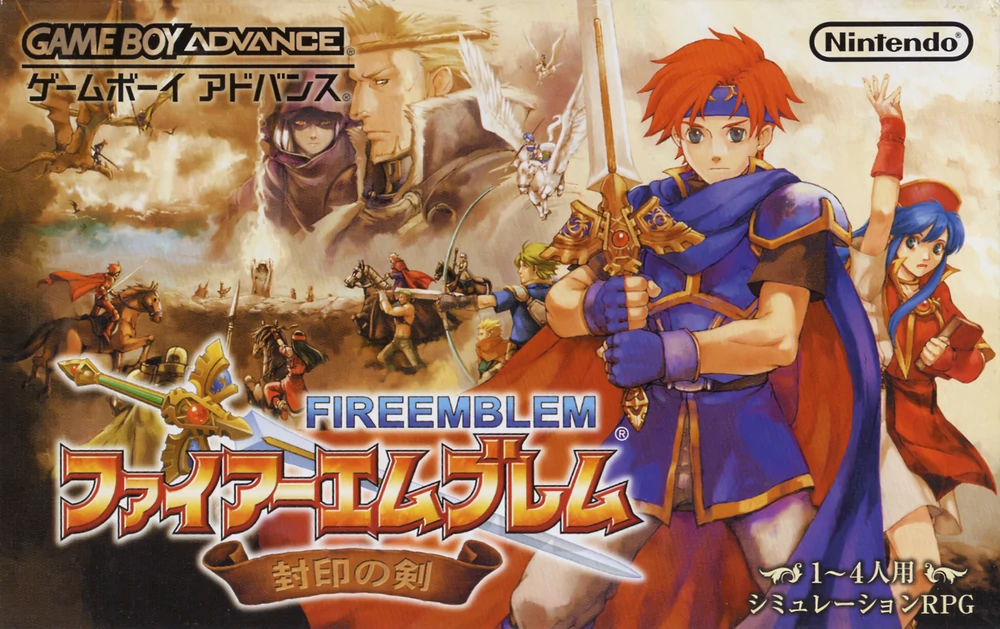User: Bluemothsword/Sandbox: Difference between revisions
No edit summary |
|||
| (136 intermediate revisions by the same user not shown) | |||
| Line 1: | Line 1: | ||
== Fire Emblem: The Binding Blade (lost build of unreleased English localization of Game Boy Advance tactical role-playing game; existence unconfirmed; early 2000's) == | |||
== | |||
{{InfoboxLost | {{InfoboxLost | ||
|title=<center>Fire Emblem | |title=<center>Fire Emblem The Binding Blade</center> | ||
|image= | |image=FE6_Boxart.png | ||
|imagecaption= | |imagecaption=Boxart of the original version. | ||
|status=<span style="color: | |status=<span style="color:grey;">'''Existence Unconfirmed'''</span> | ||
}} | }} | ||
''Fire Emblem: The Binding Blade'' is the sixth title in the long running ''Fire Emblem'' franchise, and the first to be released on handheld consoles. It was first released in March 29th, 2002 in Japan, and would later be rereleased on the Wii U Virtual Console on September 2nd, 2015. The game is best known for introducing the recurring support system, sparking international interest in the franchise as a result of its protagonist Roy's appearance in ''Super Smash Bros. Melee'', and its troubled development history. | |||
Following the release of the game, '''Nintendo of America confirmed that they have plans to localize it for international audiences'''<ref>[https://archive.rpgamer.com/news/Q2-2002/041202b.html RPGamer - "Magical Vacation and Fire Emblem GBA Confirmed for North American Release"] Retrieved 10 Nov '21</ref><ref>[https://web.archive.org/web/20120321170529/http://uk.gameboy.ign.com/articles/355/355656p1.html# IGN - "Fire Emblem Hits Japan Airwaves"] Retrieved 10 Nov '21</ref> in the wake of Marth and Roy's international popularity, albeit with no exact release date announced. However, despite this, it was quietly cancelled for unknown reasons. This led to its prequel, ''The Blazing Blade'', becoming the first in the franchise to be released internationally instead, making ''The Binding Blade'' the only Game Boy Advance title, as well as the last non-remake game that has yet to be released overseas. Outside of the initial announcement, it is unknown if this localization has ever been produced, as very little information of it has been provided, and no screenshots or evidence of its existence have been found as of yet. | |||
== | ==See Also== | ||
===Articles about ''The Binding Blade''=== | |||
*[[Fire Emblem: The Binding Blade (lost early builds of Game Boy Advance tactical role-playing game; 1997-2002)]] | |||
*[[Fire Emblem: Maiden of Darkness (lost build of cancelled Nintendo 64DD tactical role-playing game; 1997-2000)]] | |||
*[[Fire Emblem: The Binding Blade promotional trial maps (lost promotional DLC of Game Boy Advance tactical role-playing game; 2002)]] | |||
=== Other Fire Emblem-related media === | |||
*[[Fire Emblem Wii (lost tech demo; late 2000s)]] | |||
*[[Fire Emblem: Archanea Saga (partially lost original Satellaview version of "Fire Emblem: New Mystery of the Emblem" bonus content; 1997)]] | |||
*[[Fire Emblem: Three Houses (partially found original Cristina Vee audio from English dub of Nintendo Switch tactical role-playing game; 2018-2019)]] | |||
[[ | |||
* | |||
==External Links== | ==External Links== | ||
*[https:// | *[https://fireemblemwiki.org/wiki/List_of_Trial_Maps_in_Fire_Emblem:_The_Binding_Blade#Downloadable_Trial_Maps NIWA ''Fire Emblem'' Wiki page detailing the trial maps from ''The Binding Blade''. This link redirects to a section about the missing promotional maps.] | ||
==Reference== | ==Reference== | ||
{{reflist}} | {{reflist}} | ||
Latest revision as of 19:11, 20 November 2021
Fire Emblem: The Binding Blade (lost build of unreleased English localization of Game Boy Advance tactical role-playing game; existence unconfirmed; early 2000's)
Fire Emblem: The Binding Blade is the sixth title in the long running Fire Emblem franchise, and the first to be released on handheld consoles. It was first released in March 29th, 2002 in Japan, and would later be rereleased on the Wii U Virtual Console on September 2nd, 2015. The game is best known for introducing the recurring support system, sparking international interest in the franchise as a result of its protagonist Roy's appearance in Super Smash Bros. Melee, and its troubled development history.
Following the release of the game, Nintendo of America confirmed that they have plans to localize it for international audiences[1][2] in the wake of Marth and Roy's international popularity, albeit with no exact release date announced. However, despite this, it was quietly cancelled for unknown reasons. This led to its prequel, The Blazing Blade, becoming the first in the franchise to be released internationally instead, making The Binding Blade the only Game Boy Advance title, as well as the last non-remake game that has yet to be released overseas. Outside of the initial announcement, it is unknown if this localization has ever been produced, as very little information of it has been provided, and no screenshots or evidence of its existence have been found as of yet.
See Also
Articles about The Binding Blade
- Fire Emblem: The Binding Blade (lost early builds of Game Boy Advance tactical role-playing game; 1997-2002)
- Fire Emblem: Maiden of Darkness (lost build of cancelled Nintendo 64DD tactical role-playing game; 1997-2000)
- Fire Emblem: The Binding Blade promotional trial maps (lost promotional DLC of Game Boy Advance tactical role-playing game; 2002)
- Fire Emblem Wii (lost tech demo; late 2000s)
- Fire Emblem: Archanea Saga (partially lost original Satellaview version of "Fire Emblem: New Mystery of the Emblem" bonus content; 1997)
- Fire Emblem: Three Houses (partially found original Cristina Vee audio from English dub of Nintendo Switch tactical role-playing game; 2018-2019)
External Links
Reference
- ↑ RPGamer - "Magical Vacation and Fire Emblem GBA Confirmed for North American Release" Retrieved 10 Nov '21
- ↑ IGN - "Fire Emblem Hits Japan Airwaves" Retrieved 10 Nov '21
